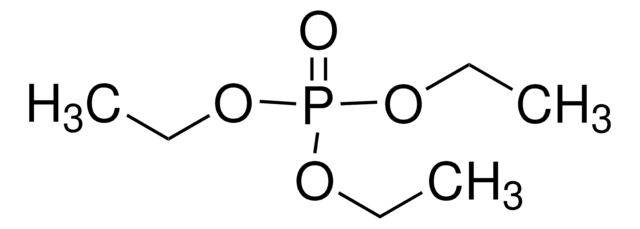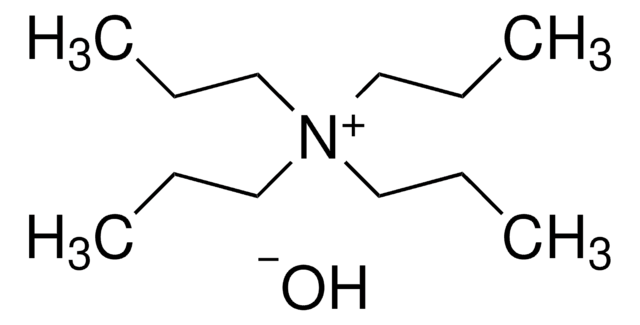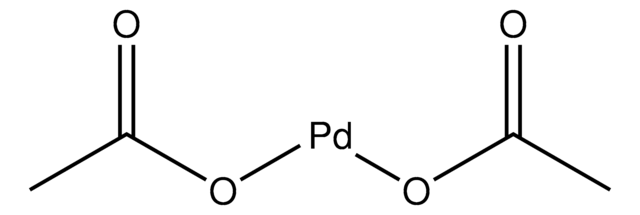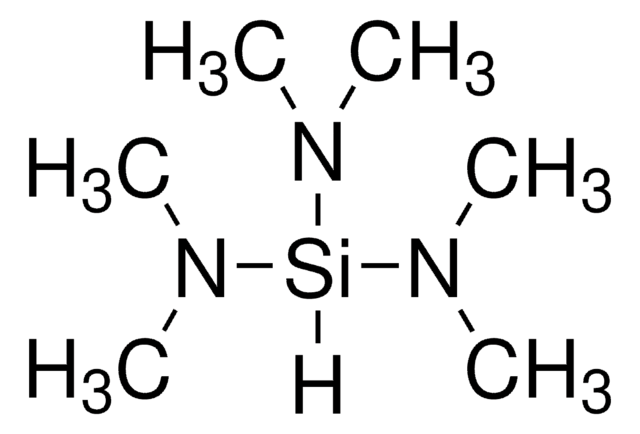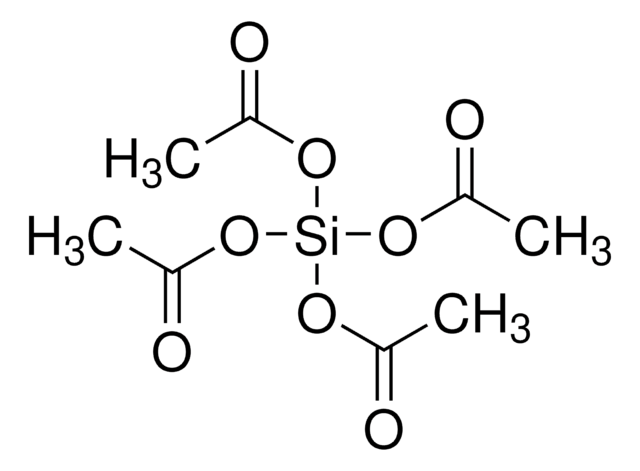推荐产品
蒸汽密度
7.2 (vs air)
蒸汽壓力
<1 mmHg ( 20 °C)
化驗
≥99.5% (GC)
形狀
liquid
折射率
n20/D 1.382 (lit.)
bp
168 °C (lit.)
密度
0.933 g/mL at 20 °C (lit.)
SMILES 字串
CCO[Si](OCC)(OCC)OCC
InChI
1S/C8H20O4Si/c1-5-9-13(10-6-2,11-7-3)12-8-4/h5-8H2,1-4H3
InChI 密鑰
BOTDANWDWHJENH-UHFFFAOYSA-N
正在寻找类似产品? 访问 产品对比指南
應用
Tetraethyl orthosilicate (TEOS) is an oxygen containing precursor of Si used for the deposition of:
The films can be deposited at low temperatues (<250 °C). TEOS is also used to deposit mesoporous and nanoporous thin films of silica. These porous films can be doped during deposition to further enhance their properties.
- Si oxide
- Oxycarbide
- Doped silicate
- Silanol
- Siloxane polymer
- Organosilicon thin films
The films can be deposited at low temperatues (<250 °C). TEOS is also used to deposit mesoporous and nanoporous thin films of silica. These porous films can be doped during deposition to further enhance their properties.
将与十二胺相互作用形成 H+-麦烃硅钠石的插层化合物,并用于混合金属生物活性玻璃的研究。
常用作制备干凝胶的前体
訊號詞
Warning
危險分類
Acute Tox. 4 Inhalation - Eye Irrit. 2 - Flam. Liq. 3 - STOT SE 3
標靶器官
Respiratory system
儲存類別代碼
3 - Flammable liquids
水污染物質分類(WGK)
WGK 1
閃點(°F)
113.0 °F - closed cup
閃點(°C)
45 °C - closed cup
其他客户在看
Andreas Kay et al.
Journal of the American Chemical Society, 128(49), 15714-15721 (2006-12-07)
Thin films of silicon-doped Fe2O3 were deposited by APCVD (atmospheric pressure chemical vapor deposition) from Fe(CO)5 and TEOS (tetraethoxysilane) on SnO2-coated glass at 415 degrees C. HRSEM reveals a highly developed dendritic nanostructure of 500 nm thickness having a feature
Nils R Blumenthal et al.
Proceedings of the National Academy of Sciences of the United States of America, 111(45), 16124-16129 (2014-10-29)
Extracellular soluble signals are known to play a critical role in maintaining neuronal function and homeostasis in the CNS. However, the CNS is also composed of extracellular matrix macromolecules and glia support cells, and the contribution of the physical attributes
Seong Cheol Hong et al.
International journal of nanomedicine, 6, 3219-3231 (2012-01-13)
Superparamagnetic iron oxide nanoparticles (SPIONs) have been widely utilized for the diagnosis and therapy of specific diseases, as magnetic resonance imaging (MRI) contrast agents and drug-delivery carriers, due to their easy transportation to targeted areas by an external magnetic field.
Evan M Hetrick et al.
Biomaterials, 30(14), 2782-2789 (2009-02-24)
The ability of nitric oxide (NO)-releasing silica nanoparticles to kill biofilm-based microbial cells is reported. Biofilms of Pseudomonas aeruginosa, Escherichia coli, Staphylococcus aureus, Staphylococcus epidermidis, and Candida albicans were formed in vitro and exposed to NO-releasing silica nanoparticles. Replicative viability
Lin Lin et al.
Colloids and surfaces. B, Biointerfaces, 101, 97-100 (2012-07-17)
Hollow silica spheres with round mesoporous shells were synthesized by core-shell template method, using monodispersed cationic polystyrene particles as core, and TEOS (tetraethoxysilane) as the silica source to form shell. After calcination at 550°C, uniform spheres with a thin shell
我们的科学家团队拥有各种研究领域经验,包括生命科学、材料科学、化学合成、色谱、分析及许多其他领域.
联系技术服务部门

